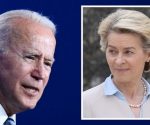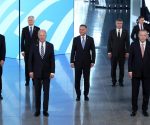Ryder Cup: The inside story of golf’s biggest postponement
[ad_1]
A weekend where the drive for individual glory gives way to a need to succeed for the team. Where suddenly any concern over prize money or world ranking is forgone for the sheer pride of representing your country, or your continent.
It was meant to be the weekend of the 43rd Ryder Cup, fought between Team USA and Team Europe. But it isn’t.
A sporting event’s cancellation — or in this case, postponement — is nothing new in 2020, a year in which virtually every tournament, league, and village table tennis championship has been affected in one way or another by Covid-19.
But sitting where it did in the calendar, in late September, for a while it seemed some small tweaks to the format might allow the Ryder Cup to go ahead.
“Things started coming to a head in March when they started closing down the tours,” Team Europe’s captain, Padraig Harrington, told CNN’s Living Golf.
“At that stage we started making all sorts of alternative options, what we’d do with picking the team, how we get in the right amount of play, and just making all different scenarios for selection, qualification, picks, timings, all that.”
But as the pandemic spread and the early optimism over fans returning to the grandstands faded, hope quickly diminished and in July, the decision was announced that Whistling Straits — the Wisconsin course hosting the event — would have to wait another year, as the Ryder Cup was postponed until September 2021.
No fans, no Ryder Cup
With the PGA Tour resuming in June, and the European Tour following suit in July, it was clear that golf could still go ahead in pandemic conditions. But for the Ryder Cup, it wasn’t as simple as just playing behind closed doors.
The organizers and players knew this was a tournament that needed fans.
In July, European Tour CEO Keith Pelley told CNN: “If you couldn’t guarantee 15 or 20,000 fans, then the Ryder Cup is not the Ryder Cup. It is tribal in nature. And that first tee experience is the best experience in golf undeniably. If you couldn’t have that, would that be detrimental to the Ryder Cup? I personally felt it would.”
Throughout the lengthy decision-making process, Pelley was in near-daily contact with his counterpart Jay Monahan, Commissioner of the PGA Tour, but also with some of Team Europe’s star players.
“I remember saying to Rory [McIlory], ‘Who are you going to raise your hands to? Patrick Reed’s caddy? Who’s Patrick going to shush? The marshal?’ That’s the magic of the Ryder Cup.”
Having played in six Ryder Cups between 1999 and 2010, Harrington understands the importance of the crowd to the event.
“The buzz, the excitement, the pressure, the stress. Everything that the crowd brings to it, it just lifts you up during the week. I don’t think it would be a Ryder Cup without it.”
The impact of a fanless tournament would have stretched beyond the course.
But even more lucrative are the global TV deals. “TV doesn’t want to house the event unless it’s top class TV,” Harrington explained.
“They don’t want to host sporting events with shallow ratings, they want the good ratings so they knew they needed spectators.”
The knock-on impact of postponement
With its postponement, the Ryder Cup returns to its biennial spot in odd-numbered years.
From 1947 to 1999, this was its traditional spot in the calendar, but after the grounding of flights in the wake of 9/11, the 2001 Ryder Cup at The Belfry in England was postponed to the following year.
Since then the Ryder Cup has taken place in even-numbered years, with the Presidents Cup — Team USA’s alternate biennial match against a ‘rest of the world apart from Europe’ side — taking place in the odd years.
For Pelley, the realignment of the traditional ‘cup years’ is one of the silver linings to the postponement.
“You can look at it and say, ‘Oh, my word, that’s incredibly detrimental to your business. How are you going to be able to survive financially?’ But you can also look at it completely differently and go, ‘Oh, it’s a great positive. It gets us back onto the rotation that we always wanted with the odd years.'”
The move knocks the Presidents Cup back into even years, and also gives Europe an extra year to prepare the Marco Simone course in Rome for hosting the 2023 Ryder Cup.
“I’m not saying it wouldn’t have been ready for 2022,” Pelley explained. “But one more year to get an Italian Open and for Marco Simone to mature as a golf course is a significant advantage for us.”
As for the captains — and in turn the players — one more year to wait could have a sizable impact on who gets selected for each team.
While some players seem nailed on for a spot in the tournament — the likes of Rory McIlroy and Jon Rahm for Team Europe and Dustin Johnson and Bryson DeChambeau for Team USA — there are 12 places to fill for each team, and an extra year is sure to see some changes in who makes the cut.
From a European perspective, Harrington admits he already has his eye on some younger candidates for next September.
“It actually gives some time to some young kids to make the ’21 team,” he says. “The Hojgaard twins, they’re only 18, they were too young this year, but next year? Sam Horsfield is obviously coming to play.
“It gives the younger players a chance to play their way in, which is obviously a little tough on the older guys because they’re a year older. But things will change by 2021.”
It may prove vital for Team Europe that things do change. With eight of the world’s current top 10 players coming from the US, Europe will have their work cut out if they are to claim victory on American soil.
While the 12-month grace period can’t guarantee that fans will be able to attend the tournament at Whistling Straits, it at least facilitates the possibility — and as all the organizers agree, a Ryder Cup is no Ryder Cup without fans.
“I think it was the right choice,” Harrington concludes. “Hopefully next year we’ll be in a lot better place.”
[ad_2]
Source link













